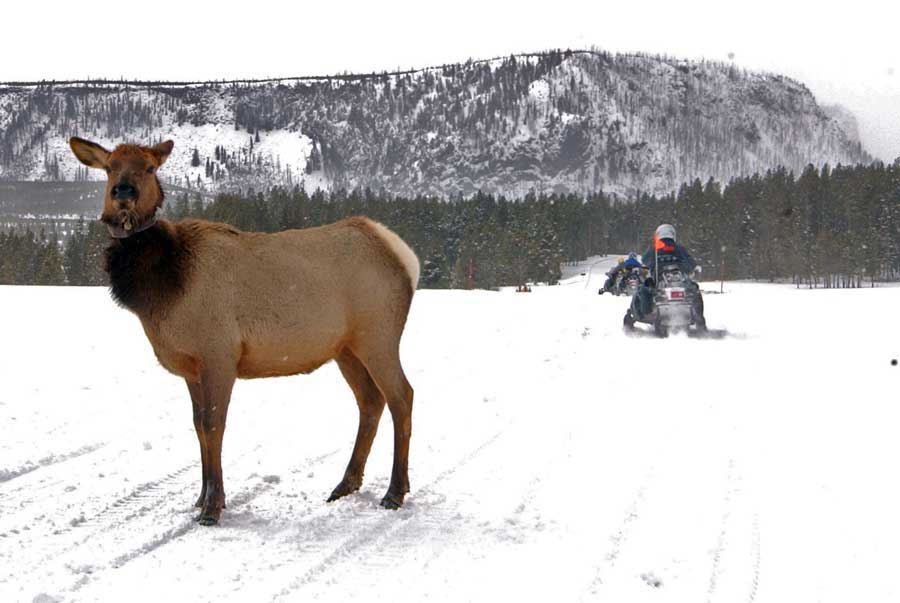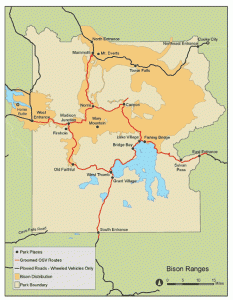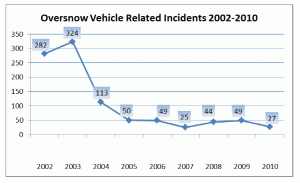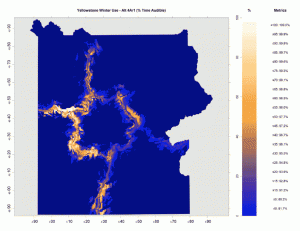
By Ruffin Prevost
CODY, WYO. — Yellowstone National Park Superintendent Dan Wenk said Thursday that he believes the park’s newly released draft winter-use plan is “complicated,” but also “incredibly defensible,” and that it will lead to a quieter, cleaner winter experience for visitors.

Answering questions during a conference call with reporters, Wenk said the plan represents an important departure in thinking about how to measure and manage the effects of winter visitation in the park. But “only time will tell,” he said, how the plan fares in federal court, as well as the court of public opinion. The plan seeks to move away from specific numerical limits for individual snowmobiles and snow coaches, focusing instead on addressing the effects of traffic clusters as they move through the park.

If the plan survives expected court challenges — the last decade has seen constant legal wrangling over snowmobiles in the park — it will take effect in 2014, after a two-year transition period that follows current rules.
Wenk and park planners will be discussing the plan later this month during public meetings in gateway communities around the park.
On Thursday, some questions from reporters focused on how the plan uses a complex new approach of “transportation events” to govern vehicle traffic.
“We’ve tried simple, and simple doesn’t work,” Wenk said of the ongoing dispute over fixed limits on winter traffic. “This is complicated, but we think complicated will work.”
The current plan allows up to 318 snowmobiles and 78 snow coaches daily, while the proposed plan would impose a daily a limit of 110 total “transportation events” entering the park, with no more than 50 daily transportation events involving snowmobiles. A transportation event would be either one snow coach or an average of seven snowmobiles in a group. While that could mean a theoretical total of 480 snowmobiles in the park at once under the new plan, the average maximum daily use would be about 342.
Everyday numbers are likely to be significantly lower, as last winter saw an average of less than 200 snowmobiles and 40 snow coaches each day.
Reframing the debate
Wenk and Yellowstone planners are seeking to reframe the debate from counting snowmobiles to focusing on mitigating winter vehicle noise, air pollution and disturbances to wildlife. By grouping travelers into clusters, they say, the new plan can address those concerns while also allowing for increased visitation.
Early reaction to the plan has been mixed, with some snowmobile advocates saying they are pleased to see sleds still allowed in the park, while some environmental groups have expressed concern that sound and emissions levels could potentially be higher under certain circumstances in the new plan.
The draft plan calls for Sylvan Pass to remain open and to be managed as in recent years based on an agreement worked out between park officials and groups from Cody, Wyo. and elsewhere. The 8,524-foot pass between the East Gate and Fishing Bridge is prone to avalanches, and park workers use a howitzer canon to mitigate that risk.
The cost of that effort is just under $125,000 annually, according to planning documents, a figure much lower than some earlier estimates ranging up to $350,000. The lower figure was reached after a re-examination of costs that excluded East Gate and Lake area operations not specifically associated with avalanche management, Wenk said.

With only 110 people entering the park by Sylvan Pass last winter, Wenk said the cost was justified “because Yellowstone is an incredible place to visit in winter,” and that while managing Sylvan Pass is costly, “there are costs of other entrances as well.”
The chance for visitors to enter without hiring a commercial guide may boost traffic over Sylvan Pass and at other entrances, as the draft plan allows for one unpaid guide to lead up to four people each day from each entrance.
Guides will have to be certified under a program yet to be developed, and those riding with the guide will have to pass a visitor education course as well. An online lottery system will be used to let unpaid guides reserve up to two travel dates per season for a $10 fee each time.
Best technology
Unpaid and commercial guides, along with their riders, must use best-available technology snowmobiles under the new plan, phasing in tougher sound and emissions standards by 2017.
Wenk said that snowmobile manufacturers had been making quieter, cleaner machines up until about 2006, but that since then, they have been making louder, dirtier sleds. Though the industry hasn’t yet made a machine that will meet the 2017 standards, Wenk said the best current technology “comes very close” and should be able to close the gap by then.
“We are asking the industry to deliver on the promises they made in 2004 and ’05,” he said.

All snow coaches will be required by 2017 to meet EPA tier 2 emissions requirements, an industrywide regulatory standard applied to new car, light truck and SUV production in recent years.
While the park’s BAT standard will make for cleaner and quieter snow coach rides, it won’t be cheap for some concessioners to make the necessary upgrades. Planning documents state that about a dozen newer machines in the current fleet of 78 snow coaches serving Yellowstone would meet the new standards, but most would not. Upgrades would cost an estimated $35,000-$165,000 per vehicle for a total estimated cost of more than $1.7 million to make the entire fleet compliant.
The plan also calls for adaptive management guidelines that will allow planners to make adjustments as necessary if, for instance, new technologies produce significantly quieter and cleaner snowmobiles. Wenk said the National Park Service will be seeking input on those adaptive management guidelines, as well as other portions of the plan that must be more fully developed before it takes effect in 2014.
The Park Service will receive public comments on the draft plan until Aug. 20, and will release a final plan in September. The Park Service intends to have a final supplemental environmental impact statement, including a Record of Decision and a long-term regulation, in place in time to govern the start of the 2012-2013 winter season.
Public meetings are scheduled in gateway communities around the park later this month. They will include an open house portion, a presentation by park staffers and a question-and-answer period.
Yellowstone Park planners will host public meetings from 6:30-8:30 p.m. in each of these gateway towns:
- Monday, July 16 in Jackson, Wyo. at The Virginian Lodge and Convention Center, 750 W. Broadway.
- Tuesday, July 17 in West Yellowstone, Mont. at the Holiday Inn, 315 Yellowstone Ave.
- Wednesday, July 18 in Bozeman, Mont. at the Wingate by Wyndham, 2305 Catron St.
- Thursday, July 19 in Cody, Wyo. at the Holiday Inn, 1701 Sheridan Ave.
Contact Ruffin Prevost at 307-213-9818 or [email protected].
